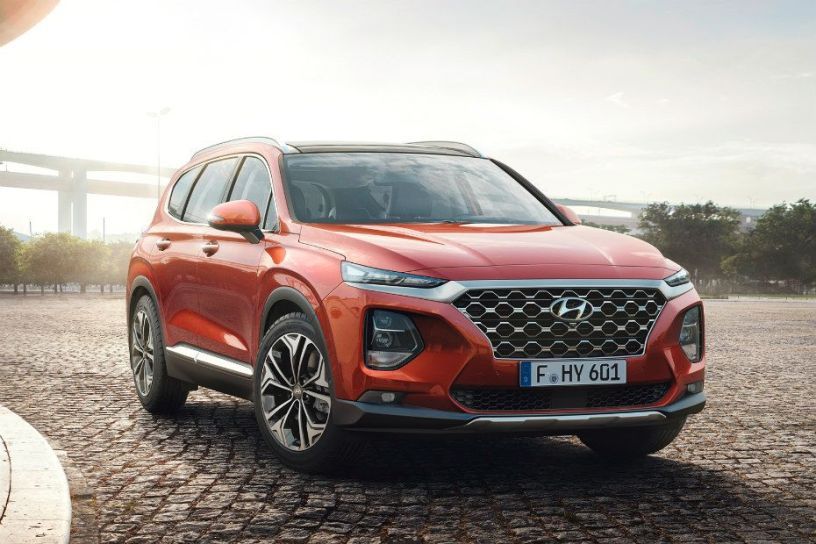2019 Hyundai Santa Fe: All You Need To Know About Fortuner, Endeavour Rival
Published On Mar 14, 2018 07:22 PM By Raunak
- Write a comment
The fourth-generation Santa Fe adorns Hyundai’s latest design language for SUVs and packs a host of additional features

The fourth-generation of Hyundai’s Santa Fe made its public debut at the 2018 Geneva Motor Show. The SUV is set to go on sale in all major markets in the coming years and is expected to arrive in India in 2019 via the CKD (completely knocked down) route.

Hyundai discontinued the third-generation Santa Fe last year owing to dwindling sales. In fact, Hyundai decided to not bring the Santa Fe facelift, which was launched in global markets in 2015, to our shores. When the Korean carmaker launched the Santa Fe in 2014, it didn’t have any direct monocoque-based competitor in the country. However, with an expected price tag of around Rs 30 lakh, the fourth generation SUV will now have to compete against the Skoda Kodiaq and the VW Tiguan. Apart from the two MQB-based SUVs, the Santa Fe will also take on popular body-on-frame SUVs such as the Ford Endeavour and the Toyota Fortuner. So, let’s take a deeper look at what it has to offer for Indian SUV buyers.
Check out: Mahindra To Launch Rebadged Rexton In India In 2018; Will Rival The Fortuner, Endeavour

- The fourth-gen Santa Fe is available with a 2.4-litre naturally-aspirated petrol engine (185PS/241Nm) along with two diesel engine options - a smaller 2.0-litre motor, which is offered in two states of tune (150PS or 182PS with 397Nm of torque) along with a range-topping 2.2-litre engine which powered the now discontinued India-spec Santa Fe. Out of these three, only the 2.2-litre diesel is expected to be introduced here as it is the more powerful of the three while being comparable to the diesel engines that power the Ford Endeavour and the Toyota Fortuner. Since it’s monocoque rivals are offered with state-of-the-art dual clutch automatic gearboxes, we expect the Santa Fe to be launched with an 8-speed automatic transmission.
- It gets Hyundai latest HTRAC all-wheel-drive system. The unit controls the torque distribution and braking power of the front and rear wheels to maximise traction
- Active safety features include blind-spot collision warning, forward collision-avoidance assist with pedestrian detection, rear cross-traffic collision-avoidance assist, lane keeping assist, rear occupant alert, safety exit assist and speed limit info function.
- Like before, the Santa Fe will be available with up to 6 airbags. The Skoda Kodiaq leads on this front in this segment by offering up to 9 airbags.
Check out: Skoda Kodiaq: First Drive Review
Design and features

Like the previous-gen model, the new Santa Fe, too, looks sharp and striking. However, both the SUVs bear no resemblance to each other. The new one is relatively boxy and butch-looking when compared to the old model. This is due to its upright stance and increased glass area.

It features Hyundai’s latest family design for SUVs that made its debut with the Kona. The key highlights are the split headlamps and the large cascading grille.

A thick chrome element joins the grille and the daytime running LEDs, which Hyundai likes to call ‘Composite Light’, into a single unit. The main headlamps are placed on the bumper and offer twin projector lamps and indicators. The cornering lights are placed further down on the lower extremities of the bumper.

There's a prominent character line that runs across the length of the SUV, making it appear longer than the previous generation. The window area has also been increased, especially the rear quarter glass (+41 per cent).

The new generation Santa Fe can be had with either 18- or 19-inch wheels. If you opt for the larger wheel, you get 235.55 cross-section tyres all around. The previous India-spec model was shod with 235/60 cross-section tyres mounted on 18-inch wheels. The wheel arches are now more squarish when compared to circular ones on the older model. The all-around body cladding has been retained as well.

The rear profile of the new model resembles that of the older SUV with its wrap-around LED tail lamps.

The lamp setup at the rear mimics the one at the front with its split layout in which the indicators and reversing lamp are placed on the bumper. Hyundai has also retained the twin exhaust tips seen on the older Santa Fe.

Like its exterior, the interior of the Santa Fe is completely revamped and looks minimalistic when compared to the slightly cluttered setup on the older Santa Fe.

The redesigned dashboard gets a wing-shaped design element on top that appears to extend into the front door pads as well.

It gets a floating 8-inch touchscreen system that supports Google Android Auto and Apple CarPlay apart from a host of other features. Provides a wireless inductive charging pad (Qi standard) for mobile phones and two fast charging ports for second-row passengers.

The front seats are 10-way power adjustable.

Gets an analogue+digital instrument cluster and an 8-inch head-up display

The boot space is rated at 625-litres with the third-row down

Here are vitals of the fourth-gen Hyundai Santa Fe:
| Dimensions |
Third-Gen Santa Fe (Old) |
Fourth-gen Santa Fe (New) |
| Length |
4690mm |
4770mm (+80mm) |
| Width |
1880mm |
1890mm (+10mm) |
| Height |
1690mm |
1680mm (-10mm) |
| Wheelbase |
2700mm |
,765mm (+65mm) |
| Ground Clearance |
185mm |
185mm |

| Specifications |
Third-Gen Santa Fe (Old) |
Fourth-gen Santa Fe (New) |
| Engine |
2.2-litre CRDI Diesel |
2.2-litre CRDI Diesel |
| Power |
197PS @ 3800rpm |
197PS @ 3800rpm |
| Torque |
420Nm (MT)/ 436Nm (AT) @ 1800-2500rpm |
436Nm @ 1750rpm |
| Transmission |
6-speed MT/AT |
6-speed MT/ 8-speed AT |
Check out: Top 5 SUVs At Auto Expo 2018: Tata H5X, Mahindra Rexton And More















